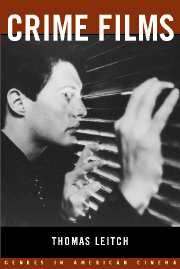Book contents
- Frontmatter
- Contents
- List of Illustrations
- Acknowledgments
- 1 The Problem of the Crime Film
- 2 Historical and Cultural Overview
- 3 Critical Overview
- 4 Fury and the Victim Film
- 5 The Godfather and the Gangster Film
- 6 Double Indemnity and the Film Noir
- 7 Basic Instinct and the Erotic Thriller
- 8 Murder on the Orient Express, Blue Velvet, and the Unofficial-Detective Film
- 9 Chinatown and the Private-Eye Film
- 10 Bullitt and the Police Film
- 11 Reversal of Fortune and the Lawyer Film
- 12 Fargo and the Crime Comedy
- 13 Conclusion: What Good Are Crime Films?
- Notes
- Selected Bibliography
- Filmography/Videography
- Index
8 - Murder on the Orient Express, Blue Velvet, and the Unofficial-Detective Film
Published online by Cambridge University Press: 27 October 2009
- Frontmatter
- Contents
- List of Illustrations
- Acknowledgments
- 1 The Problem of the Crime Film
- 2 Historical and Cultural Overview
- 3 Critical Overview
- 4 Fury and the Victim Film
- 5 The Godfather and the Gangster Film
- 6 Double Indemnity and the Film Noir
- 7 Basic Instinct and the Erotic Thriller
- 8 Murder on the Orient Express, Blue Velvet, and the Unofficial-Detective Film
- 9 Chinatown and the Private-Eye Film
- 10 Bullitt and the Police Film
- 11 Reversal of Fortune and the Lawyer Film
- 12 Fargo and the Crime Comedy
- 13 Conclusion: What Good Are Crime Films?
- Notes
- Selected Bibliography
- Filmography/Videography
- Index
Summary
It is commonplace to observe that films noirs, whose criminals are amateurs, differ in crucial ways from gangster films, whose criminals are professionals. It is equally true that the different kinds of character who are called on to solve crimes — officials of the justice system like lawyers or the police, licensed private detectives who make their living investigating crimes, unofficial detectives who work neither for the justice system nor as salaried independent contractors — emphasize problems so different that they generate distinctive subgenres within the crime film. Films featuring officers of the justice system are organized around problems of institutional justice (What should society do with suspected or convicted criminals?), films featuring private investigators around problems of professionalism and masculinity (What sort of man makes the best detective?), and films featuring amateur detectives around problems of knowledge (What is the solution to the mystery?).
Throughout the century since the vogue of Sherlock Holmes, unofficial detectives have played a leading role in the history of the detective story. Although Edgar Allan Poe had produced the first detective story, “The Murders in the Rue Morgue,” as early as 1841, it was the Holmes stories — A Study in Scarlet (1887), The Sign of the Four (1890), and especially the series of short stories Arthur Conan Doyle published in the Strand, beginning with “A Scandal in Bohemia” in 1891 — that provoked a torrent of imitators in England and America who first made the detective story an established literary genre.
- Type
- Chapter
- Information
- Crime Films , pp. 170 - 191Publisher: Cambridge University PressPrint publication year: 2002



